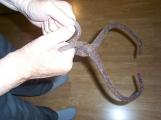1
CUTTING AND KEEPING ICEThe only way of preserving fresh fish for any length of time was with the use of ice. The boats would take some along, especially if they were to be out overnight. The large boats used for shipping the fresh fish also needed a
supply of ice.
It became necessary to keep ice for the use of the fishery well into the summer. So the "ice house" came into being.This structure was a tall narrow shed built without windows. There the ice was stored in blocks, and buried in sawdust. The ice would be set at a distance from each wall, and each layer would be separated by sawdust, which was also packed in around the walls. In this way ice could be kept until July.
If it was a hot summer day, you could step inside the ice house and experience a blessed coolness. Most companies would pack about 100 tons in a building, stacking higher by means of pulleys.
Where did all this ice come from ?In early winter, a pond or brook area would be dammed up to cause flooding, which produced a great skating rink as well. By midwinter the desired thickness of ice, at least ten inches, would be
achieved, and the harvest began. A drag rigged with a double-bladed cutting apparatus, the two blades about twenty-five or thirty inches apart, would be hitched up to the ox or horse. This was used to mark and cut into the ice, marking it off in squares.
Then the workers laboured with ice saws, cutting the ice by hand. As the blocks were cut, they were grasped with ice tongs and hauled over to the carts or sleighs to be taken to the ice house by the ox or horse.
It was tricky and difficult work, but it was another source of short term labour for a number of young boys and men. One young fellow took an unexpected dip while using the tongs, and he was docked an hour's pay for the time it took to go home and change his icy clothes.
In the later years of this period, the ice making machine appeared, and each fish plant had to be equipped with this apparatus, which produced tons of ice daily, and worked around the clock.
This was another example of the co-operation of the people in the area, as the sawdust was obtained from local sawmills.
By Carol Welch
2
Ice Plow used to establish guide lines for hand sawing ice blocks1930
Islands Museum, Tiverton, Nova Scotia, Canada

5
Small ice tongs used to carry a block of ice from the ice house.1930
Tiverton, Nova Scotia, Canada

7
Daniel Kenney Sr. talks about the days before ice machines.DBK:All the ice we had was in January and February, the tides down in George Morrell's pond, we'd put up 25 or 30 tons of ice to last us through the halibut season. The fishermen would take some with them when they would go to stay overnight. So, other than that we didn't have anything. Not in the ice line. There wasn't any refrigeration of any kind. Not until, I think I had the first ice plant up at MacLaughlans, I put one in and that was only a five ton. Now they got them and make 20 or 30 ton a day, 24 hours.
D:Where was George Morrell's pond?
DBK: George Morrell's pond was down - you know down where that chap from Freeport [Roy Small] lives. Anyway, right straight down, that flat land down there, the pond is still there but they left the dam open and it is all opened up now. But that's where they use to flood it like in December, put the gate across and let it fill up and then they cut ice with a horse, they'd cut it and marked it out. Had a machine to mark it out, and saw it by hand. Melbourne MacDormand was another one, he put up 100 ton, then Bower's would put up 100 ton, different people would put it up for their own use. Then we use to bury it in sawdust. Take and leave it so far from the wall all the way around and just put the sawdust right straight around and then cover it with sawdust and it would keep until July. They did it all over, the Crocker's in Freeport, they did it Connor Bros. there, Frank E. Davis, they all put up ice. But at that time there was no refrigeration,it was just beginning.
D: So where did you get all the sawdust?
DBK: Got that at the mills. Tupper Warren's in Digby, use to go up in the truck and load the truck. But once you got the sawdust, what you did, you used it. You kept shovelling back - you'd uncover it and you'd leave the sawdust right there and after you got all through, you'd take the sawdust out and dry it and put it in boxes and have it for the next year. Once you had the sawdust, you had it. There was a lot to it.
D: So did they tow something behind the horse to mark it?
DBK: Yeh, it was like a big blade that cut and mark it right along. They'd mark it off at first, the cakes were very equal too, they'd mark it off and then they'd just take the horse and it had a sharp blade on it, quite deep, then at the end of it they had to saw it by hand. They cut down so far because they couldn't go over it because the horse would go through it.
D: About how deep would the blocks be?
DBK : Oh, 10 or 12 inches, and about 25 or 30 inches square. It was good ice, though. It would last a lot longer than this thin ice because it was big cakes and we'd have it all through lobstering, halibut fishing and into the summer. And then after that we got so that Sweeney's brought a lot of ice down there and he use to bring bait up here and keep it here. He use to get so much ice to keep until we started to get our own refrigeration. Yep, been a lot of changes.
D: And how much was left? Once you cut that block that was about 12 inches, did they have to flood it again?
DBK: Oh, not the pond -that pond was large. It was large, I don't know how long it would be. We use to go skating there - it was very large. It was 400 or 500 feet long, easy, and couple hundred feet wide. What they would do was flood it and it would go way up on the marsh land and flood the whole thing. But he had made a dam right along the road and filled it right in. They use to put this plank in to seal it off and fill it right up.
Interview conducted April 21, 2003 by Dorothy Outhouse
9
Raymond Robicheau talks about the ice houses in Westport:"I remember Jimmy's pond down there and they would cut ice the end of January and it would be 2 feet thick down there. Great big chunks - 2x2x4x4,big ice cakes and they would put it in the ice houses for the fish for the next summer, in sawdust.... It would keep. They'd break that open and shovel the sawdust off it in the middle of August and it'd still be right there all caked together. Every one of the fish firms had their own ice house. In fact, we (R.E. Robicheau Ltd.) still have one. We use it for a lumber shop now, down to the store. That was used for an ice house for the E.C. Bowers Company years ago.
Taken from an interview conducted by Brenda Teed in 2000 for Passages.
10
Items from local scrapbooks held by Island Historical Society:During the past three weeks many tons of ice have been cut and hauled for Hains Bros., M.G. Crocker and others.
Central Grove, 1901
G. Delaney and others were busily engaged for the last few days in cutting and hauling ice to Tiverton.



